Top News
August 18, 2014 Ryukyu Shimpo
The government is controlling the residents by force in Henoko, Nago. As far as we know, the government has never unleashed such reckless disregard of the will of the people, as we have seen at Henoko. The Ministry of Defense installed salvage barges in the sea of Henoko for undersea drilling for building an air base to replace Marine Corps Air Station Futenma. The government has clamped down on the resistance in the past. However, 74 percent of Okinawan people oppose the Henoko relocation. We wonder if there has ever been a case like this, where the government has trampled on the will of the overwhelming majority of people in the prefecture elsewhere in Japan. This action by the government evokes memories of the crackdown against peasants during the Edo period. The same repression also took place in Japan’s annexation of the Ryukyu Kingdom and the Battle of Okinawa. Japan’s annexation of the Ryukyu Kingdom is called “Ryukyu Shobun” or disposal of the Ryukyu Kingdom, in 1879. In 1944 during the Battle of Okinawa, the Japanese military in Okinawa issued a decree that “the military, the bureaucracy and the people will all live as one, and die as one.” Okinawan people were forced to commit mass suicide. This history is a form of structural discrimination against Okinawan people, if such incidents have never taken place elsewhere in Japan. This is a barbaric action by the government, and so shameful if the international community just stands by.
Government ignores provisions of the Constitution
In Henoko, the government has responded with an attitude that they will allow physical force, even injury on residents who are against the government. They have shown their hostility and malice towards the residents. We have felt empty and completely discouraged. Particularly, the Japan Coast Guard showed its hard-line stance,. They asserted, “to ensure safety.” It is a quite ridiculous pretence. On August 15, crew-members of the coast guard removed a protester forcibly. At that time, his broken glasses cut his face. This is ironic because they caused injury to a resident despite saying they were removing him for his safety.
For the first time in the 18-year saga of the Henoko relocation plan, the government has unilaterally set up an always-off-limits water area in Oura Bay without any legal basis. This is a method employed by the government to deprive the residents of the right to access the sea. It is the same as that used by rulers during the Edo period. The coast guard has detained citizens outside of the off-limits area without showing legal basis. They gave a warning to residents who were sailing from a fishing port to protest against the work. They threatened, speaking in loud voices, the residents who were approaching the off-limits area. The Constitution provides that “no person shall be deprived of liberty without due process of law.” The coast guard has also violated Article 35 of the Constitution that provides for the principle of warrant. Thus, Japan is not a law-abiding country.
These acts are questionable on a legal basis. Who are outlaws of the sea, the residents or the coast guard? We suppose the Japan Coast Guard had better change its name to the “Security Service for construction of US military base” in the future. We know the efforts made by the 11th Regional Coast Guard Headquarters to win credibility from the residents after Okinawa’s reversion to Japan in 1972. They are now appear to be trashing the credibility of the organization in Henoko, in just a few days. We would like the coast guard to know the reality of Okinawa. Even so, there is an irony about the saga on the sea of Henoko. The Ministry of Defense, Japan, safeguards the U.S. forces, which is the strongest military power in the world. The Japan Coast Guard and the police protect the Ministry of Defense. Security of a private company are placed on the front line. People who are supposed to hold the power and interests involving national defense, including diplomatic and defense officials, are observing the conflict between the residents and the security guards from a safe heigh.
A sacrifice stone to protect mainland Japan again
Prime Minister Shinzo Abe reportedly cross-examined defense officials about why the construction work was delayed and strongly urged them to accelerate the work. This is revealed in a new report by a lawmaker close to the prime minister. According to the report, the Falklands war waged by the U.K. in South America, boosted the flagging support rate for the Thatcher cabinet. The Abe administration appears to have learned from historical precedents in which state leaders acquired their centripetal forces by fuelling nationalism. Prime Minister Abe has taken a tough stance against China over the disputed Senkaku Islands. The Abe administration is determined to build a new air base in Henoko to get the U.S. forces involved in the Senkaku Islands dispute. They are sacrificing beautiful nature, land, and the safety of Okinawa as a tribute to the United States to gain its favour.
A perspective of Henoko reminds us of a strategy employed by the Japanese Imperial Army during the Battle of Okinawa. They made use of Okinawa, a “sacrifice stone” in order to postpone the decisive battle in mainland Japan. This strategy destroyed Okinawa. The coast guard has prevented the boats hired by news media from approaching the waters. The government is trying to punish the people who access information that it does not want to let them knowThis is a step forward to the reign of terror. The landfill approval by Okinawa Governor Hirokazu Nakaima has led to this confusion. His approval of the landfill permit has no legitimacy because he acted contrary to his pledge for the election. The government should stop the work in Henoko immediately if Japan is a democratic country. In the gubernatorial election in November, candidates should ask voters whether they approve or disapprove construction of the air base in Henoko.
(English translation by T&CT)
Go to Japanese
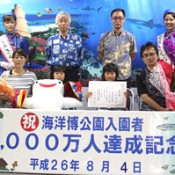
August 5, 2014 Ryukyu Shimpo
On August 4, the Ocean Expo Park in Motobu welcomed its 80 millionth visitor since it opened 38 years ago. It held a ceremony to honor Haruka Yatou, the 9-year-old lucky girl who came from Aichi Prefecture with her family members. She received a commemorating certificate and gift, including a stuffed whale shark that she said was her favorite. She said, “I was really surprised, but I am very happy.”
Souji Katayama, the director of the Okinawa Commemorative National Government Park, commented, “We are striving to work towards commemorating our one hundred millionth visitor, and then two hundred millionth visitor in the future.”
The Ocean Expo Park opened on August 1, 1976. It welcomed its 70 millionth visitor in 1978. Since then, it hosted 80 millionth visitor in two years and seven months.
(English translation by T&CT, Hitomi Shinzato)
Go to Japanese
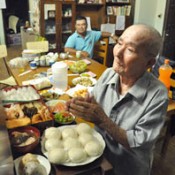
August 12, 2014 Masaaki Umeda of Ryukyu Shimpo reports from Bolivia.
On the night of August 10, the last day of Obon of the lunar calendar, in Colonia Okinawa in Bolivia, Okinawan immigrants held the ukui ceremony. Members of migrant families gathered at their houses and sent off their ancestral spirits. Many Okinawan people and their descendants live in Colonia Okinawa.
At the house of Masaji Ikehara, 91-year-old from Sobe, Yomitan, and 12 of his relatives, including his children, grandchildren and great-grandchildren, gathered. His wife passed away in 2001 when she was 86. He placed an order with a Bolivian carpenter to make a memorial tablet called Totome in Okianwan dialect and an altar for Obon. He and his relatives prayed, asking their ancestral spirits to come back on the night of ukui.
At the altar, they placed multitiered boxes in which the Okinawan traditional Obon foods such as radishes, kelp and pork were contained.
Masaji came to Bolivia in 1958 as a member of an migrant group sponsored by the Ryukyu Government. He said, “I live now in a place that is far away from my home country. Even so, we pray for the spirits of ancestors at an altar in the same way we used to in Okinawa.” He is proud of Okinawan customs and rituals.
The family placed the lanterns at the entrance of the house, so their ancestors’ spirits could go back to the future world without losing their ways.
(English translation by T&CT)
Go to Japanese
August 10, 2014 Akiko Kuwabara of Ryukyu Shimpo
To increase export cargo from Okinawa, RKK Shipping Lines Co. will start including 10-feet containers in its regular container shipping service from September. By using containers smaller than usual, the company aims to increase small cargo exports. RKK LINE also wants small-and-medium-sized companies in Okinawa to promote the service.
The company uses a route connecting Hakata, Kagoshima, Naha, Miyako, and Ishigaki with Gaoxiong in Taiwan. The company ships cargo collected at Gaoxiong from various countries to Naha. It ships cargo containing daily commodities on the route between Hakata and Ishigaki before heading to Taiwan, where no goods are shipped because of the container size.
The company focuses on utilizing vacant space effectively and securing export cargo.
The International Organization for Standardization usually asks shipping companies to use containers of 20 or 40-feet in length for international shipping. In many cases, ports cannot deal with 10-feet containers.
RKK LINE negotiated with port managers in Taiwan and got their approval to use 10-feet containers temporarily.
The company operates a RORO ship once a week on the Taiwan route. It leaves from Naha on Friday night and arrives in Gaoxiong on Sunday morning.
Hiroshi Takasaki of the company said, “Using RORO ships is cheaper than airplanes and takes less time to transport goods than container ships.” He went on to say, “Including 10-feet containers in a regular container shipping services can lead to increasing the amount of small-shipment cargo. We would like Okinawan companies thinking of expanding from small shipments to overseas transportation, to use the service.”
(English translation by T&CT)
Go to Japanese
August 13, 2014 Ryukyu Shimpo
August 13 marked 10 years since a U.S. Marine CH-53D helicopter crashed into a building at Okinawa International University in Ginowan City. Currently, 24 MV-22 Osprey aircraft are stationed at U.S. Marine Corps Air Station Futenma near the university. MV-22 vertical takeoff and landing transport aircraft have repeatedly crashed in the United States and abroad. These aircraft land and take off continuously with roaring engine noises day and night near the base and all over the island. This dangerous situation, in which Okinawan people have been forced to live, has not been improved despite ten years having passed since the incident.
One U.S. aircraft crash for every year since Okinawa’s reversion to Japan
After the reversion of Okinawa to Japan in 1972, 45 crashes involving U.S. military aircraft have occurred. Four mishaps took place after the crash at Okinawa International University. This suggests that U.S. military aircraft have crashed more than once a year in Okinawa since 1972. We wonder how long it will take before we can live with peace of mind.
Ryukyu Shimpo recently carried out a questionnaire on the 10th anniversary of the U.S. chopper crash into Okinawa International University with 41 heads of municipalities in the prefecture. Thirty of them responded to the questionnaire. Among respondents, there was no one who answered, “U.S. Marine Corps is necessary to be stationed in Okinawa.” We would like to say there is no need to allow the U.S. Marines to be stationed in Okinawa, as some heads of the municipalities believe.
Satoshi Morimoto, a former Democratic Party defense minister, said, referring to the relocation site of the Futenma base, that “it may not be best to station the marines within Okinawa from a military point view, but Okinawa is the best place politically.” There was recently a move to test his claim. The government proposed a plan that it would move U.S. marine MV-22 osprey aircraft to Saga Airport from Futenma tentatively. However, this plan could not be carried out because the United States side is reluctant to accept it. The government itself has shown that it is possible to relocate a part of the functions of the Futenma base to places outside of Okinawa.
There is no reason why US Marines should stay in Okinawa
The U.S. military listed some reasons why it is not realistic to move the Osprey aircraft to Saga Airport tentatively. These reasons are, they say, the following: The marines and their family members have housings in Okinawa, and the marines can use the northern training area in the island. However, if you view it differently, it is indeed possible to move the marines from the Futenma base outside of Okinawa, if the government provides housings and training areas. There are candidate places in other prefectures, where the marines can use Japanese Self-Defense facilities with airfields and training areas. Japan and the United States assert that Okinawa is geopolitically superior from the strategic point of view. This is an illusion.
The Ministry of Defense has published a booklet, in which they highlight the role and significance of the U.S. Marine Corps’ presence in Okinawa. In the booklet, they describe Okinawa as located in an appropriate place that is neither too close to, nor too far from potential conflict regions such as the Taiwan Strait and the Korean Peninsula. They suggest that Okinawa’s geopolitical superiority is the basis for deterrence in the regions. However, this is a pretense to place U.S. military bases in Okinawa, and their argument has been proven illogical.
The United States intends to rotate the Marine Air-Ground Task Force (MAGTF) in Okinawa to Guam, Australia and Hawaii. The MAGTF consists of forces such as headquarters, ground combat, aviation combat and logistical support teams belonging to Camp Hansen, Futenma base and Makiminato Service Area. Okinawa is within China’s ballistic missile range. Some experts speculate that the United States can reduce risk for the marines by rotating them outside of Okinawa. We would like the United States to withdraw all U.S. forces from Okinawa to a safe place.
Currently, the government is carrying out relocation work for the Futenma base in Henoko, Nago. On August 11, the Okinawa Defense Bureau reinstalled float bridges on the coast near Camp Schwab. They will install buoys and floats to conduct undersea drilling surveys.
According to an opinion poll carried out on April by Ryukyu Shimpo, 74 percent of people are opposed to the Henoko relocation plan for the Futenma base. The government has gone ahead with the construction work in Henoko, ignoring the majority of people who are against it. We will never accept such action because it is not fitting for a democratic nation. The government should stop the construction. This sea and sky belong to Okinawan people. The governments of Japan and the United States have reached a point where they must seriously consider a way to withdraw the Marines from Okinawa.
(English translation by T&CT)
Go to Japanese
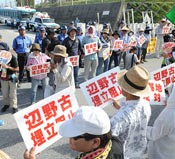
August 14, 2014 Ryukyu Shimpo
The U.S. and Japanese government were about to set up a number of sea buoys and floats marking out an area for building a new U.S.military base around the investigation spots in Henokozaki. The new base is part of a replacement of Marine Corps Air Station Futenma. At the former gate of Camp Schwab on August 13, More than 100 people of all ages from in and outside Okinawa have become determined to protest against what the governments plan to do. One of them said, “We cannot allow them to set up buoys off the Henoko district.” Another claimed, “Okinawan people should gather to prevent the government from sealing the area for the land reclamation work.”
While construction vehicles came and went, the citizens continued to voice protest against the plan. After 4:10 p.m., Hiroji Yamashiro, the director of the Okinawa Peace Movement Center, asked the shouting protesters to huddle together. All of them sang a song titled Give Us Back Okinawa.
Yamashiro shouted at the top of his voice, “We will reach a critical point tomorrow. Be determined to voice protest against the reckless construction from the gate.” The citizens expressed their agreement and applauded.
Some of the protesters sang ryukyuan traditional songs such as Hutami Joowa or Asadoya Yunta. Masako Toguchi said, “Singing songs makes us feel united and makes the atmosphere positive. That’s how the participants interact with one another.” A poet and picture book writer Arthur Bernard from Hiroshima Prefecture said that if the new base is built, there would be more to come. He went on to say that Okinawan people have no other choices but to keep protesting.
(English translation by T&CT)
Go to Japanese

August 7, 2014 Ryukyu Shimpo
The opening ceremony and pep rally of the “2014 Kin Emigrant Youth Trainee Friendship Project,” which hosts children of Kin-born emigrants for a cultural training program, took place at Kin town hall on August 1. Six trainees from five countries will stay in Okinawa until mid-November, learning Japanese language, Ryukyuan dance, sanshin, and other aspects of Okinawan culture.
The project began in 1996, and this is the 19th iteration. To date, 62 people have been accepted.
The six trainees in the 2014 batch are Bolivian Airi Kikuyama, 20; Argentine Kaori Yonagi, 19; Brazilian Higa de Almeida Carmen Tiyoko, 22; Peruvian Shinzato Yge Aldo Hideharu, 20; American Gagola Sarah Ann Miki, 21; and American Ige Christopher Kiki Jordan, 23.
Higa expressed her determination, to get the most out of the program saying, “Haitai. I am very happy to have come to Kin. I want to learn a lot of culture here, so I can teach many things to my family and friends when I return to Brazil.”
Smiling, Yonashiro said, “I learned Ryukyuan dance and sanshin when I was a child. I especially want to learn dance.”
Kin Mayor Hajime Nakama said, “In many countries the transition to the 3rd and 4th generations is continuing, and through this project we would like to continue the connection Kin has with these countries. I look forward to all the trainees becoming cultural bridges when they return to their home countries.”
(English translation by T&CT and Lima Tokumori)
Go to Japanese
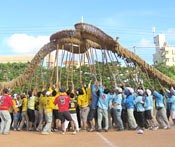
August 9, 2014 Ryukyu Shimpo
The community association in the Oyama district of Ginowan held the Great Tug-of-War, at an athletic field of Oyama Elementary School on July 27. The tradition has a history of over 100 years.
Divided into two groups, Mendakari and Kushindarari, the residents competed against each other. The community association in the Makishi district of Ginowan also held a tug-of-war, blocking Convention Street on July 20 for the event. The event attracted many participants.

Residents in the Makishi district took part in the tug-of-war. At Convention street on July 20.
In Oyama, hatagashira, parades carrying large flags, led both Mendakari and Kushindarari, which marched through the district to spectators’ cheers.
After both groups arrived at the athletic field, they kicked off the competition with a Gae performance, in which participants waved about 30 kilograms of flags for hatagashira, and acted out an Agie performance, in which one group struck their rope to the other’s.
(English translation by T&CT)
Go to Japanese

August 11, 2014 Ryukyu Shimpo
On August 10, the All Okinawa Togyu (Bullfighting) Summer Tournament was held, sponsored jointly by the Okinawa Prefectural Bullfighting Federation and the RyukyuShimpo Co., at the Ishikawa Multipurpose Dome in Uruma City. About 20 young and veteran bulls gathered from Okinawa for the champion titles in the lightweight and middleweight divisions. About 2,500 people cheered for the bulls, which demonstrated their skills and techniques furiously in clouds of dust.
Tosho Hayate defended its sixth champion title successfully in the middleweight division weighing no more than 970 kilograms. Hayate defeated Yushinfujiwaka at the end of the tough fight, after they rammed horns fiercely for 18 minutes and 30 seconds.
Ryutenryuonimaru won the title of the lightweight division of 850 kilograms or less for the first time on its third try. The bull beat Daijyaoh, attacking the opponent’s belly using its horn.
(English translation by T&CT)
Go to Japanese
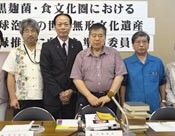
August 5, 2014 Ryukyu Shimpo
On August 4, the Awamori Meister Association launched a preparatory committee to promote the inscribing of Awamori, which is made of Aspergillus luchuensis, to the list of UNESCO World Cultural Heritage. Following Japanese cuisine, which was listed on the World Heritage list last year, the Association focuses on registration of Okinawan food culture. Takeo Koizumi, emeritus professor of Tokyo Agricultural University, served as a committee member for registering Japanese cuisine and he is one of Awamori promoters. He said, “Okinawa is the only place in the world that uses Aspergillus luchuensis for food. Calling for cooperation from Okinawans, we hope Awamori will be inscribed on the list.”
The committee held a press conference on August 4. Masaaki Yasuda, professor emeritus at the University of the Ryukyus, will serve as a committee chairperson. The head of the association Masaru Arakaki said, “Aspergillus luchuensis is a treasure of Okinawa. It is used not only for Awamori, but also for food. I hope Okinawans can work together to register Awamori to the UNESCO World Cultural Heritage list.” Misako Tamanaha, a chairperson of the Brewers Association of Okinawa, said, “Awamori production techniques, which use Aspergillus luchuensis, have been developed while keeping traditional techniques. Registration on the list will promote Awamori to the world.”
At the press conference, Koizumi said, “Aspergillusluchuensis, which has a history of more than 400 years, is rooted in Okinawan food culture. I have been expecting that Aspergillus luchuensis will be the next one to be registered after Japanes” uisine.” Koizumi also lectured at the workshop for local municipality assembly members. He stressed, “We need cooperation from residents and local governments. Registration as part of World Heritage will create positive economic effects.”
At the end of May on the 10th anniversary of the association, Koizumi declared his intention to register Awamori to the list. Secretary-General Masayasu Kawai of the Okinawa General Bureau and Okinawa Vice Governor Yoshihisa Kawakami will serve as emeritus members of a preparatory committee. On September 18, the first committee meeting will be held. On November 30, the committee will hold the first symposium, and file a request to the Okinawan governor. They will then call for cooperation from the Japanese government and related institutions.
(English translation by T&CT and Megumi Chibana)
Go to Japanese
August 7, 2014 Ryukyu Shimpo
While the Japan International Cooperation Agency (JICA) stopped sending teachers to Bolivia in fiscal 2012, the organization has decided to resume the program in the next fiscal year.
In the 189th Multiracial Nation Bolivia Independence Ceremony, the head of the JICA Okinawa International Center Makoto Kashiwaya announced the decision. According to Kashiwaya, JICA plans to recruit teachers and choose the candidates next March.
After taking a training course for two months, the selected teachers will be sent to Bolivia next June.
JICA is now asking the Education Ministry to decide on a schedule for selecting candidates. The ministry will respond to the organization this summer.
The selected teachers will be sent to Bolivia as volunteers.
The teachers are scheduled to stay in Bolivia for two years. They will teach students in Japanese Bolivian schools and Nueva Esperanza Elementary and Junior High School. They will also train the local teachers in educational methods.
Kashiwaya said, “We plan to continue to send our teachers to Bolivia.” The head of the Okinawa Association of Bolivia Masaki Terada said, “I heard this news today. It is great. I think the relationship between Japan, Okinawa and Bolivia will further deepen.”
(English translation by T&CT)
Go to Japanese








 Webcam(Kokusai Street)
Webcam(Kokusai Street)


